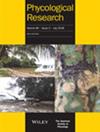大叶绣线菊提取物对 1、2 型单纯疱疹病毒和牛冠状病毒的抗病毒潜力
IF 1
4区 生物学
Q2 MARINE & FRESHWATER BIOLOGY
引用次数: 0
摘要
摘要富含褐藻糖的硫酸化多糖(如褐藻糖)主要存在于褐藻中。这些化合物具有开发抗病毒和抗氧化药物的有趣药理学前景。主角褐藻(脊索动物门,外果藻纲)是阿根廷巴塔哥尼亚特有的一种褐藻,与脊索动物门中其他用作褐藻糖商业来源的成员相似。在本研究中,用稀盐酸(pH 值为 2)溶液萃取 M. major,这是获取褐藻糖胶通常使用的方法。不同提取阶段(E1 和 E2)的两种提取物的干重占提取干生物量的 42%。化学分析显示,提取物的多糖中含有 15%(E2)和 20%(E1)的硫酸酯和大约 80%的岩藻糖成分。总酚含量低于 1%(没食子酸当量)。我们分析了这些提取物对抗单纯疱疹病毒(HSV)-1、HSV-2 和牛冠状病毒的抗氧化活性。当两种提取物的浓度为 1 mg mL-1 时,其抗氧化活性均低于 50%。我们的研究结果表明,在这些提取物存在的情况下,病毒的吸附和内化可减少 75%。通过利用其抗病毒作用阻断病毒感染,宿主细胞释放出的后代病毒受到了显著限制,而不会影响病毒在细胞间的传播或病毒的存活率。本文章由计算机程序翻译,如有差异,请以英文原文为准。
Antiviral potential of extracts from Myriogloea major against herpes simplex type 1, 2 and bovine coronavirus
SUMMARYFucose‐rich sulfated polysaccharides such as fucoidans are primarily found in brown algae. These compounds possess interesting pharmacological perspectives for antiviral and antioxidant drug development. The brown alga Myriogloea major (Chordariaceae, Ectocarpales) is an endemic brown alga from Argentine Patagonia similar to other members of the Chordariaceae family used as a commercial source of fucoidans. In the present study, M. major was extracted with diluted hydrochloric acid (pH 2) solution in a protocol usually utilized for obtaining fucoidans. The dry weight from two extracts at different extraction stages (E1 and E2) represented 42% of the extracted dried biomass. Chemical analysis showed that the extracts contained between 15% (E2) and 20% (E1) of sulfate esters and approximately 80% of fucose constituents on their polysaccharides. The total phenolic content was lower than 1% (gallic acid equivalents). We analyzed the antioxidant activity of these extracts against the anti‐herpes simplex virus (HSV)‐1, HSV‐2 and bovine coronavirus. The antioxidant activity was lower than 50% at a concentration of 1 mg mL−1 in both extracts. Our findings demonstrate that, in the presence of these extracts, the viral adsorption and internalization were reduced by up to 75%. By applying its antiviral action to block the viral infection, the progeny virus released from host cells was significantly restricted, without affecting cell‐to‐cell spread of virus or virus viability.
求助全文
通过发布文献求助,成功后即可免费获取论文全文。
去求助
来源期刊

Phycological Research
生物-海洋与淡水生物学
CiteScore
3.60
自引率
13.30%
发文量
33
审稿时长
>12 weeks
期刊介绍:
Phycological Research is published by the Japanese Society of Phycology and complements the Japanese Journal of Phycology. The Journal publishes international, basic or applied, peer-reviewed research dealing with all aspects of phycology including ecology, taxonomy and phylogeny, evolution, genetics, molecular biology, biochemistry, cell biology, morphology, physiology, new techniques to facilitate the international exchange of results. All articles are peer-reviewed by at least two researchers expert in the filed of the submitted paper. Phycological Research has been credited by the International Association for Plant Taxonomy for the purpose of registration of new non-vascular plant names (including fossils).
 求助内容:
求助内容: 应助结果提醒方式:
应助结果提醒方式:


